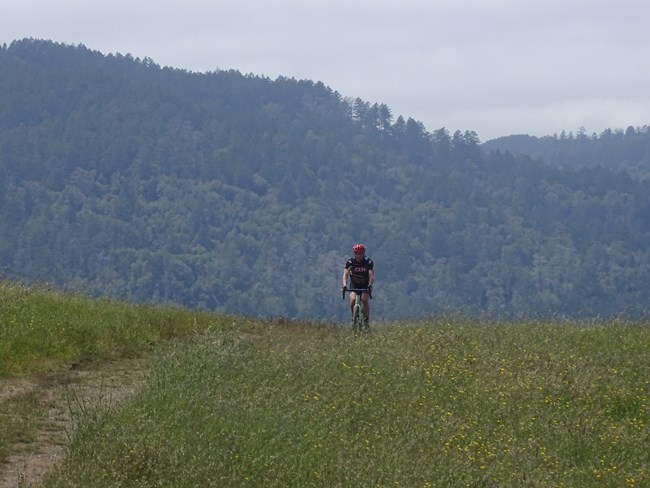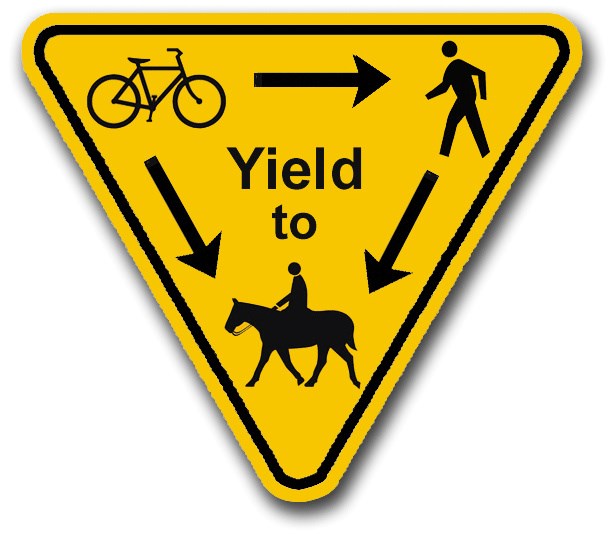
NPS Photo Point Reyes National Seashore provides a variety of off-road biking opportunities traversing diverse habitats and terrains. You can explore trails through evergreen forests, coastal scrub, or along estuaries and beach bluffs. Visitor Centers offer a free map of the park's trails, indicating which trails are designated for bike travel. These maps are also available to download from our Maps page. Point Reyes permits biking only outside of wilderness areas along emergency access/dirt fire roads, paved roads and a few single-track trails. Carry plenty of water!Electric bicyclesAn electric bicycle (aka e-bike) is a two or three wheeled cycle with fully operable pedals and an electric motor of less than 750 watts (1 h.p.) that provides propulsion assistance. In order to provide for resource protection, minimize conflicts between users groups, and due to the nature of the multi-use routes within the park, e-bike usage is limited to Class I e-bikes where traditional bikes are allowed and as listed below, except as noted (Abbotts Lagoon Trail). Only class I e-bikes are permitted; class II and class III e-bikes are prohibited. E-bikes are prohibited where traditional bikes are prohibited. Except where use of motor vehicles by the public is allowed, using the electric motor to move an e-bike without pedaling is prohibited. 
Yield to all other UsersHorseback riders have right-of-way on the trails with hikers coming second. Bicyclists must yield to both of these trail user groups. Be aware that many horses are easily spooked when approached from behind. Reduce your speed when approaching horses or hikers. When approaching from behind, announce your presence. Stop on the downhill side of the trail while horses pass. The speed limit for bicycists on all trails, even when headed downhill, is 15 mph, and 5 mph when passing others or approaching blind turns. Be courteous. If trails are dry and dusty, slow down even more so as not to leave hikers in a cloud of dust. Yellow JacketsIn the summer and fall, reports of yellow jacket activity along trails increase. Park staff will post notices at appropriate trail junctions warning hikers of the presence of yellow jacket nests located in close proximity to the trail as nests are discovered and/or reported. Please use an alternate route if you are allergic, want to avoid any risk of yellow jacket stings, or are riding a horse. Please notify park staff at 415-464-5100 x2 x5 if you encounter a swarm of yellow jackets along a trail that has yet to be posted. Visit our Your Safety Around Yellow Jackets for more information. Group Size LimitsThe maximum number of bicyclists in any one group is 10. Larger groups of cyclists will have to divide into groups no larger than 10. This size restriction is necessary for the safety of cyclists using public roadways and authorized trails within the Park. These roadways and trails are narrow and winding and will not safely accommodate large numbers of bicyclists. Trail HazardsCaution: Loose dirt and gravel cover many of the trails. This slick surface can be difficult to maneuver in and can make for easy slide outs. The loose dirt can also hide potholes. These technical riding surfaces challenge even the most experienced bikers. We recommend always wearing a helmet, a long-sleeved shirt and long pants. CattleIf you plan to ride your bike on a trail that leads through cattle pasture, please read Understanding Working Rangelands: Sharing Open Space: What to Expect from Grazing Livestock (1,314 KB PDF). By understanding basic cattle behavior, you can give yourself a better chance to predict how cattle are likely to react to your presence and in response to your actions. This will help make your ride through these areas safer and more enjoyable. Invasive WeedsTo help control the spread of non-native plants, please:
More Information
Trails Open to BicyclesWithin Point Reyes National Seashore, bicycles and class I e-bikes are only permitted on the following trails:
Within the north unit of Golden Gate National Recreation Area, bicycles are permitted on the following trails (listed from north to south):
Trail Guide Multimedia:Bicyclists and other visitors to Point Reyes may find our Wilderness Videos page to be of interest. There we feature multiple videos about the Phillip Burton Wilderness and Leave No Trace® outdoor ethics. Select Route Descriptions |
Last updated: August 13, 2024
